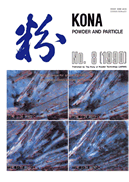Volume 8
Displaying 1-29 of 29 articles from this issue
- |<
- <
- 1
- >
- >|
Front Cover
-
1990Volume 8 Pages Cover8_1
Published: 1990
Released on J-STAGE: June 30, 2014
Download PDF (307K) -
1990Volume 8 Pages EdBrd8_1
Published: 1990
Released on J-STAGE: June 30, 2014
Download PDF (830K)
The Letter from the Editor
-
1990Volume 8 Pages 3
Published: 1990
Released on J-STAGE: June 30, 2014
Download PDF (85K)
Explanation of the Cover Photograph
-
1990Volume 8 Pages 11
Published: 1990
Released on J-STAGE: June 30, 2014
Download PDF (101K)
Original Report
-
1990Volume 8 Pages 4-11
Published: 1990
Released on J-STAGE: June 30, 2014
Download PDF (523K) -
1990Volume 8 Pages 12-17
Published: 1990
Released on J-STAGE: June 30, 2014
Download PDF (469K) -
1990Volume 8 Pages 18-23
Published: 1990
Released on J-STAGE: June 30, 2014
Download PDF (424K) -
1990Volume 8 Pages 24-30
Published: 1990
Released on J-STAGE: June 30, 2014
Download PDF (445K) -
1990Volume 8 Pages 31-38
Published: 1990
Released on J-STAGE: June 30, 2014
Download PDF (504K) -
1990Volume 8 Pages 39-47
Published: 1990
Released on J-STAGE: June 30, 2014
Download PDF (555K) -
1990Volume 8 Pages 48-54
Published: 1990
Released on J-STAGE: June 30, 2014
Download PDF (407K) -
1990Volume 8 Pages 55-66
Published: 1990
Released on J-STAGE: June 30, 2014
Download PDF (710K) -
1990Volume 8 Pages 67-73
Published: 1990
Released on J-STAGE: June 30, 2014
Download PDF (484K)
Review
-
1990Volume 8 Pages 74-82
Published: 1990
Released on J-STAGE: June 30, 2014
Download PDF (730K) -
1990Volume 8 Pages 83-91
Published: 1990
Released on J-STAGE: June 30, 2014
Download PDF (552K)
Original Report
-
1990Volume 8 Pages 92-98
Published: 1990
Released on J-STAGE: June 30, 2014
Download PDF (482K) -
1990Volume 8 Pages 99-104
Published: 1990
Released on J-STAGE: June 30, 2014
Download PDF (437K) -
1990Volume 8 Pages 105-118
Published: 1990
Released on J-STAGE: June 30, 2014
Download PDF (1051K) -
1990Volume 8 Pages 119-125
Published: 1990
Released on J-STAGE: June 30, 2014
Download PDF (528K) -
1990Volume 8 Pages 126-133
Published: 1990
Released on J-STAGE: June 30, 2014
Download PDF (525K) -
1990Volume 8 Pages 134-144
Published: 1990
Released on J-STAGE: June 30, 2014
Download PDF (714K) -
1990Volume 8 Pages 145-154
Published: 1990
Released on J-STAGE: June 30, 2014
Download PDF (676K) -
1990Volume 8 Pages 155-159
Published: 1990
Released on J-STAGE: June 30, 2014
Download PDF (354K)
Information Articles
-
1990Volume 8 Pages 160
Published: 1990
Released on J-STAGE: June 30, 2014
Download PDF (96K) -
1990Volume 8 Pages 160
Published: 1990
Released on J-STAGE: June 30, 2014
Download PDF (96K) -
1990Volume 8 Pages 161
Published: 1990
Released on J-STAGE: June 30, 2014
Download PDF (96K) -
1990Volume 8 Pages 162
Published: 1990
Released on J-STAGE: June 30, 2014
Download PDF (127K)
Academic publication concerning powder technology in Japan
-
1990Volume 8 Pages 163-166
Published: 1990
Released on J-STAGE: June 30, 2014
Download PDF (228K)
New Product News
-
1990Volume 8 Pages 167
Published: 1990
Released on J-STAGE: June 30, 2014
Download PDF (597K)
- |<
- <
- 1
- >
- >|
